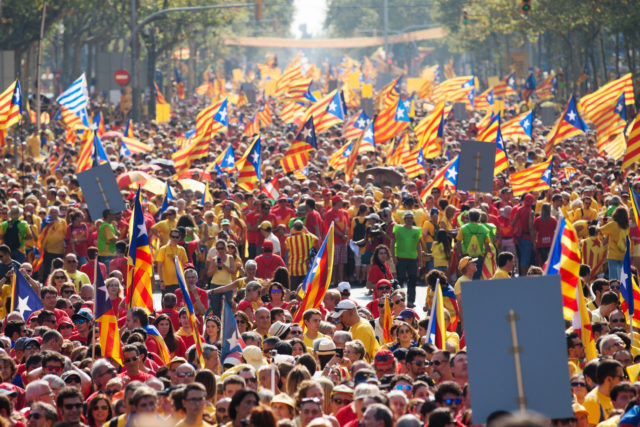
It’s no secret that the geography of Europe invites fragmentation. Its mountain chains, peninsulas and unconnected rivers led to hundreds of cultural pockets with unique languages and identities. Centuries of war, invasion and forced migration further redefined political and ethnic borders, resulting in a continent overcrowded with sovereign states. About a quarter of all the countries in the world are in Europe, and within almost every one are smaller groups demanding greater political, economic and cultural rights.
That is why Catalonia’s push for secession from Spain makes the European Union nervous. In the past few decades, not many self-determination movements within Europe have reached the magnitude of Catalonia’s. And other nations are watching closely the region’s instability, fearing that it might ignite their own separatist forces. But while many EU members will need to confront factors similar to those that drove the Catalan secessionists, each specific movement is different, existing within its country’s unique economic and political context. And Catalonia by no means offers an easy roadmap for others to follow.
Cautious Camaraderie
Most of Europe’s self-determination movements sympathize with the Catalan cause. But they rarely express interest in directly following Catalonia’s path, especially after witnessing the political and economic uncertainty its unilateral actions have created. In France, for example, the president of the regional assembly of Corsica recently hailed the “birth of the Catalan Republic,” but then admitted his small island is still not ready for independence. In Romania, the leader of the Democratic Alliance of Hungarians in Romania took a similarly cautious stance, saying that the Hungarian minority does not want independence, only the right to protect its identity. And in Spain itself, the government of the Basque country is concerned that Catalan secessionism could reignite calls for Basque separatism and possibly set the stage for Madrid to take direct control of the region as it did in Catalonia.
However, the aforementioned movements are minor compared to those in countries such as Italy, Belgium and the United Kingdom, where self-determination groups are active and powerful, often influencing the direction of their nations’ political agendas.
Italy: Avoiding Comparison
In Italy, the Alps to the north create a natural border with its neighbors, while the Apennines split the peninsula down the middle. Off the coast, the country controls the two largest islands in the Mediterranean; Sicily and Sardinia. Geographically divided and regularly subject to invasions, Italy has long struggled against fragmentation. After unifying in the 1860s, the country remained defined by strong regional identities and contrasting levels of economic development — especially between the wealthy, industrialized north and the relatively poorer and mostly agricultural south.
Northern regions generally contribute more in taxes to the Italian state than they get in return. And in recent decades, Italian self-determination sentiments have been more active in the north, defended by, among others, the Northern League political party. Born in the late 1980s, the Northern League originally focused on achieving greater fiscal autonomy for northern Italy. By the mid-1990s, the party openly demanded secession. But after a series of disappointing electoral results and a leadership change, the party embraced anti-immigration, anti-establishment and Euroskeptic rhetoric in the early 2010s to appeal to a bigger audience. It now promotes a platform closer to Italian nationalism than northern separatism.
Even if Rome does not have an Italian Catalonia on its hands, it still faces the challenge of finding a balance that satisfies the regions without jeopardizing Italy’s fiscal revenues. The fact that the League, which is popular in the north, is now a part of Italy’s coalition government means the issue could reignite in the coming months. Should Rome fail to reach such a balance, secessionist rhetoric may return.
Current opinion polls show most northern Italian voters prioritize fiscal autonomy over independence. On Oct. 22, 2017. the two northern regions of Lombardy and Veneto held non-binding referendums to address this concern, in which voters authorized their regional governments to ask Rome for more autonomy on issues such as taxes and education. Lombardy and Veneto have made it clear that their claims have nothing to do with Catalonia, arguing that they do not want independence.
Belgium: A Delicate Balancing Act
Farther north, in Belgium, the Catalan crisis puts Brussels in an uncomfortable position. Like Italy, Belgium is a divided country. There is Flanders, the Dutch-speaking north; Wallonia, the French-speaking south, and bi-lingual Brussels-Capital region. Those in wealthy Flanders are often critical of those in poorer Wallonia. And though both regions contain nationalist movements, Flemish nationalism has been particularly active in recent years, as many in Flanders consider Belgium’s system of transferring funds from wealthier regions to poorer ones unfair. Furthermore, Belgium’s complex federal government (in which Flemish and Walloon political parties must share power) tends to produce oversized coalition governments that voters see as ineffective.
The goals of Flemish nationalists vary, with some suggesting Belgium become a confederation and others demanding outright independence for Flanders. A common middle ground is the desire for Brussels to transfer additional prerogatives — on areas such as social security and justice — to the Flemish regional government.
The Catalan crisis has exacerbated the Belgian government’s struggles to stay united, especially now that the former Catalan president has fled to Brussels. Some Flemish nationalist groups are supportive of the Catalan cause, and a senior member of the New Flemish Alliance (N-VA), Flanders’ main nationalist and conservative party, recently offered asylum to deposed Catalan leaders.
But Brussels, insistent both on keeping its secessionist movements under control and on remaining loyal to the European Union, later said the N-VA’s statement did not reflect Belgium’s official position. In another balancing act, the country joined the rest of the union in supporting Spain’s territorial unity, while its prime minister, the francophone Charles Michel, appealed to Flemish nationalist sentiments by criticizing the use of violence against Catalan voters.
Still, as much as Flemish nationalists may feel a solidarity with the Catalan independence movement, they are confronting a different political reality. Opinion polls suggest that support for the N-VA has decreased in recent months, partially because of its failure to accomplish much of its socio-economic agenda since entering the federal government in 2014. Support for the right-wing Flemish nationalist Vlaams Belang party is also in decline. Meanwhile, the popularity of center-left parties unconcerned with the Flemish cause has surged. As nationalist parties approach federal elections in mid-2019, they will have to decide between radicalizing their rhetoric — possibly alienating moderate voters — and adopting more moderate positions.
The UK: More Regions, More Problems
Meanwhile, in the United Kingdom, the Catalan crisis has further complicated the already tumultuous post-Brexit landscape. The referendum to leave the European Union has renewed long-standing discussions about territorial integrity, particularly as it relates to Scotland and Northern Ireland. And Catalonia’s pursuit of independence is only fanning the flames.
In Scotland, which held an independence referendum in 2014, a majority voted to remain in the European Union. And though the governing Scottish National Party (SNP) has long been supportive of the Catalan cause, it does not want to be seen as backing unilateral moves by regional governments or antagonizing Spain and the bloc at large. The SNP is currently pushing for another independence vote and is particularly wary of damaging its valuable relationship with the European Union.
However, with London preoccupied by Brexit negotiations and the SNP in a weak position after a disappointing general election performance, a referendum seems unlikely until at least the end of Brexit negotiations in mid-2019. In the meantime, London will likely try to placate the secessionists by transferring control of certain policy areas to Scotland.
As London works to appease Scotland, it must also manage growing uncertainties within Northern Ireland. After the United Kingdom leaves the EU single market, hard borders will likely divide the Republic of Ireland, which will remain in the European Union, and Northern Ireland, which along with the rest of the United Kingdom will not. Even a comprehensive free-trade agreement would require control measures for products entering the union or the United Kingdom, jeopardizing the continuity of the Good Friday peace agreement.
The issue has put Northern Ireland’s two largest parties at odds. The nationalist Sinn Fein sees the Brexit as an opportunity to raise the issue of unification with the south, which the Democratic Unionist Party (DUP) firmly opposes. And though they are supposed to govern together, the parties have been struggling since March to reach an agreement. London has threatened to take direct control of Northern Ireland if they fail, but — especially in the wake of events in Catalonia — it will avoid intervention for as long as possible.
Practical Constraints
The reality is that as much as European countries fear independence movements within their own borders, the secessionists face dilemmas of their own. Many such movements within the European Union want to ultimately form countries that would belong to the bloc, with some believing that because their territories are already part of the union, they would automatically become members after independence. Others think that they may be temporarily excluded but would quickly qualify for membership because they already comply with the bloc’s criteria. Still others argue that by retaining passports from their previous country, citizens of a new country would continue to enjoy many of the benefits of EU membership, regardless of the new country’s status.
The bloc’s treaties do not contain specific procedures for how to address breakaway territories, but EU institutions by and large accept the principle that newly independent regions of member countries would not automatically join the union. They would need to apply for membership, and current members would have to approve them unanimously. This, of course, creates a problem for secessionist movements and makes the prospect of a unilateral secession much less appealing than one that was civilly negotiated between a region and its former country.
Thus, the Catalan crisis puts Europe’s self-determination forces in almost as much of a quandary as it does EU member states, as they struggle to support Catalonia’s mission without condoning the region’s unilateral actions. Secessionist movements will continue to threaten the territorial integrity of countries throughout Europe. But though the hearts of the secessionists may be with Catalonia, the crisis in the region has likely given their minds some lessons to reflect on.
Adriano Bosoni is senior European analyst for Stratfor, an international geopolitical intelligence firm.





